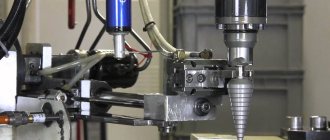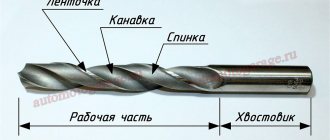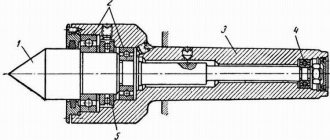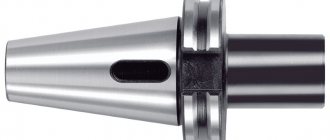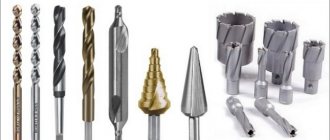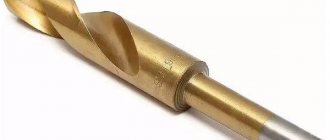Specifications
- Material of manufacture – alloy and carbon steel 9XC, as well as P9 and P18 are used. The latter belong to the category of high-speed steels and are designated as HSS. Such an alloy retains hardness when heated, and since drilling is accompanied by strong heating of both the material and the tool, the use of high-speed steel is completely justified.
- The sharpening angle is the size of the angles of the main cutting edges and the transverse one that determines the area of application of the drill. For plexiglass and other types of plastics, you need a tool with an apex angle of 60–90 degrees. An angle of 60 degrees is recommended when working with thin sheets, and an angle of 90 is recommended when drilling material with a thickness of 20 mm or more.
A small sharpening angle improves heat dissipation performance, and since acrylic glass is deformed when heated, this feature of the drill is very important for it. However, such sharpening affects the strength of the tool itself, and therefore is used only when working with non-hard materials.
- The clearance angle must be at least 15 degrees. With this sharpening, the back surface of the drill scrapes the material rather than cutting, which reduces the deformation of the plexiglass.
- Tip - in the usual case, it consists of two cutting edges with a convergence angle of 118–135 degrees. Drills are produced in which an additional chamfer is removed behind the edges - double sharpening. This option reduces friction. Another improvement is the two-stage tip for precise centering - this drill is designed for hard materials.
The diameter, length of the cone and section of the shank are regulated by GOST 10903-77.
Shortened Morse tapers
Due to the excess length of the Morse cone in some of its applications, a standard of shortened cones was formed. The cone designation contains the value of the largest diameter formed after decreasing the length while maintaining the ratio. Thus, nine standard sizes of shortened cones, B7, B10, B12, B16, B18, B22, B24, B32, B45, have become widespread when installing drill chucks and other tools.
The values of diameters D1 and d1 are theoretical and calculated and depend on the nominal dimensions D and L.
Main dimensions of shortened Morse tapers
| Cone name | N Morse taper | D, mm | D1, mm | d1, mm | amax, mm | L, mm | M | l1, mm |
| B7 | 0 | 7,067 | 7,2 | 6,5 | 3,0 | 11,0 | — | — |
| B10 | 1 | 10,094 | 10,3 | 9,4 | 3,5 | 14,5 | — | — |
| B12 | 1 | 12,065 | 12,2 | 11,1 | 3,5 | 18,5 | M6 | 16,0 |
| B16 | 2 | 15,733 | 16,0 | 14,5 | 5,0 | 24,0 | — | — |
| B18 | 2 | 17,780 | 18,0 | 16,2 | 5,0 | 32,0 | M10 | 24,0 |
| B22 | 3 | 21,793 | 22,0 | 19,8 | 5,0 | 40,5 | — | — |
| B24 | 3 | 23,825 | 24,1 | 21,3 | 5,0 | 50,5 | M12 | 28,0 |
| B32 | 4 | 31,267 | 31,6 | 28,6 | 6,5 | 51,0 | M16 | 32,0 |
| B45 | 5 | 44,399 | 44,7 | 41,0 | 6,5 | 64,5 | M20 | 40,0 |
Varieties
The tapered shank or Morse taper is available in several modifications.
- Tool ones are the most common, as they are designed for quick automatic change when working on the machine. Product parameters are regulated by GOST.
- Shortened - the tail part of the drill is reduced due to the thickened part of the cone. Marked as follows: B7 - shortened to 14 mm, B10 - to 18, and to B24 - shortened to 55 mm. This option is used when a hole is required of a certain diameter, but of small depth.
- Extended - used for drilling deep holes in several stages.
- Metric - shanks in which the ratio to the working part is 1:20, and the angle is more than 1 degree.
The photo shows varieties of drills with a conical shank
Step drills and those reinforced with plates are also available.
Spiral conical
For drilling acrylic glass and other plastics, tool drills are used, usually shortened, made of high-speed steel. Plexiglas is a viscous material, prone to deformation when heated already at 160 degrees. Therefore, the use of an HSS class drill is preferable - high-speed steel dissipates heat better.
The purpose of the drill is determined by sharpening: apex angle, clearance angle, etc. Sharpening and grinding is carried out on special machines or manually.
The recommended drilling speed for plexiglass is 500–1000 rpm.
Conical GOST
GOST 10903-77 regulates tools with a conical shank - with a Morse taper, and a version with a neck.
- Possible diameter of products is 5–10 mm.
- Cone lengths are 58–85 mm.
- The cross-section of the tail section is 6–12 mm.
Extended
Drills with an extended tail part are regulated by GOST 2092-77. They are used to produce holes of great depth.
The diameter ranges from 6 to 30 mm. The length of the tail is 145–275 mm.
Products are produced in two accuracy classes:
- A1 and A – with increased accuracy;
- B1 and B – with normal accuracy.
Conical stepped
The cone in this case looks like a pyramid, where each “step” is responsible for the formation of a hole of a certain diameter. This structure allows you to drill holes of different sizes without changing tools. Its labeling indicates a number of quantities at once.
This same feature allows you to chamfer using the same drill that was used to make the hole. The drilling speed is relatively low - up to 1000 rpm, which makes the tool very suitable for working with plexiglass.
Centering due to the conical shape is problem-free, but sensitivity to distortions is higher than that of the instrumental version.
Tools are used for processing steel, aluminum, duralumin and non-metallic materials - plastics, plexiglass, hard rubber.
Cobalt with tapered shank
To improve strength properties and heat removal, products are subjected to additional processing.
- HSS-G – undergo additional grinding;
- HSS-Co - steel contains cobalt, drills of this class are designed to work in severe temperature conditions;
- HSS-R – rolled products;
- HSS-Tin - the tool is treated with titanium nitride, the coating reduces friction, and, therefore, heating of the tool and material.
You can tell what kind of treatment the drills were subjected to by their color: bright gold indicates the deposition of titanium nitride, black means heat treatment was used, and so on.
Morse cones
The Morse taper, proposed by inventor Stephen Morse, is the most commonly used tool mounting method.
The existing division into eight sizes, from KM0 to KM7, and nine shortened sizes allows the use of a tapered shank for various cutting tools, equipment and accessories. The taper in this case varies in the ratio from 1:19.002 (at an angle of 1°25′43″) to 1:20.047 (the angle at this ratio is 1°30′26″). KM7 is not recommended for use by domestic GOST 25557-82 and instead a metric cone No. 80 is used, for example, in the spindle hole of some lathes. The standard size of the cone as a tool shank depends on the installation method and purpose of the latter, and can be either shortened or Morse tapers or with a claw.
Types
Drill bits with a tapered shank are divided into four main groups.
- Shortened. They are needed to drill shallow holes. Shortening occurs in the wide part of the cone.
- Conical. They have a cone shape and are very easy to use.
- Metric. The lengths of the shank and the working area are related as 1 to 20.
- Morse drills. The differences from metric drills are minimal. There are special sizes for this type of gimlet, there are eight in total. Both metric and Morse bits can be used to drill holes in a wide variety of materials: aluminum, cast iron, brass and bronze, and all types of steel.
To make the Morse nozzle more durable, HSS steel is used for its manufacture. This enhances the gimlet's ability to cut through steel and makes it easier to operate – even when drilling or reaming complex holes. Products with a tapered shank are ideal for drilling holes in surfaces made of materials of high strength and density. Thanks to the cone in the device, you can quickly change the nozzle to another and accurately center it.
Options for drills with a tapered shank may vary. They may have legs, and then the fastening will be carried out by fixing them in one position, then the drill will not rotate during operation. They can have a thread, and this is the most reliable option, because the rod, with which the nozzle is secured, completely prevents the drill from falling out during operation. There are also products that lack both paws and threads. They work with materials such as plastic, ebonite, plexiglass, i.e. relatively light.
There are also special drills equipped with holes or grooves to allow cutting fluid to flow into them. But nozzles with a conical shank are also popular in everyday life, because they are easy to center, in addition, they are optimal for drilling holes with large diameters, since they allow you to immediately set the desired parameters without additional drilling.
SPECIAL AND EXTENDED DRILLS WITH MK SHANK
| View the catalog Morse taper drill DIN 341 Article number: 242692 | Drills for conductor bushings DIN 1870 (GOST 12121-77) Cutting material: HSS/HSS Co Coating: steam nitrided Point angle: 130° Helix angle: 56° Tolerance: h8 Application: for drilling in steel with hardness up to 1000 N/mm2, cast steel, cast iron, malleable iron, annealed iron, nickel and graphite. Features: Standard extended drill bits designed to work through jig bushings only. |
| View the catalog Morse taper drill DIN 1870 series 1 Article: 242214 | Twist drills with Morse taper long DIN 1870 series 1 Cutting material: HSS Coating: without Point angle: 118° Helix angle: 56° Tolerance: h8 Application: for drilling in steel up to 1000 N/mm2, cast steel, cast iron, nickel and graphite. Features: Standard drills for drilling deep holes, suitable for drilling without a center drill. Drilling deep holes requires coolant, short feeds and frequent chip removal. |
| View the catalog Morse taper drill DIN 1870 series 1 (TLS 1000C) Article number: 242692 | Long Morse taper drills DIN 1870 series 1 (TLS 1000C) Cutting material: HSS-Co Coating: nitriding Point angle: 130° Helix angle: 30° Tolerance: h8 Application: designed for drilling deep holes in alloy, bearing and hardened steels with hardness up to 1300 N/mm2. Features: Provides stable drilling without coolant, special flute profile ensures excellent chip removal. The coating guarantees reduced tool wear and long-term operation. |
| View the catalog Morse taper drill DIN 1870 series 2 Article: 242118 | Extra-long Morse taper drills DIN 1870 series 2 Cutting material: HSS Coating: without Point angle: 118° Helix angle: 56° Tolerance: h8 Application: for drilling in steel up to 1000 N/mm2, cast steel, cast iron, nickel and graphite . Features: Standard drills for drilling deep holes, suitable for drilling without a center drill. Drilling deep holes requires coolant, short feeds and frequent chip removal. |
| View the catalog Morse taper drill DIN 1870 series 2 (TLS 1000C) Article number: 242692 | Twist drills with Morse taper extra long DIN 1870 series 2 (TLS 1000C) Cutting material: HSS-Co Coating: nitriding Point angle: 130° Helix angle: 30° Tolerance: h8 Application: intended for drilling deep holes in alloyed, bearing and hardened steels with hardness up to 1300 N/mm2. Features: Provides stable drilling without coolant, special flute profile ensures excellent removal of long twisted chips. The coating guarantees reduced tool wear and long service life. |
7, 8. (Introduced additionally, Amendment No. 2).
APPLICATION
Information
MAIN DIMENSIONS OF DRILLS WITH INTERMEDIATE DIAMETERS
The main dimensions of drills with intermediate diameters that differ from those regulated in the standard must correspond to those indicated in the table.
mm
| d | L | Morse cone | ||
| over | before | |||
| 4,75 | 5,30 | 155 | 74 | 1 |
| 5,30 | 6,00 | 161 | 80 | |
| 6,00 | 6,70 | 167 | 86 | |
| 6,70 | 7,50 | 174 | 93 | |
| 7,50 | 8,50 | 181 | 100 | |
| 8,50 | 9,50 | 188 | 107 | |
| 9,50 | 10,60 | 197 | 116 | |
| 10,60 | 11,80 | 206 | 125 | |
| 11,80 | 13,20 | 215 | 134 | |
| 13,20 | 14,00 | 223 | 142 | |
| 14,00 | 15,00 | 245 | 147 | 2 |
| 15,00 | 16,00 | 251 | 153 | |
| 16,00 | 17,00 | 257 | 159 | |
| 17,00 | 18,00 | 263 | 165 | |
| 18,00 | 19,00 | 269 | 171 | |
| 19,00 | 20,00 | 275 | 177 | |
| 20,00 | 21,20 | 282 | 184 | |
| 21,20 | 22,40 | 289 | 191 | |
| 22,40 | 23,02 | 296 | 198 | |
| 23,02 | 23,60 | 319 | 198 | 3 |
| 23,60 | 25,00 | 327 | 206 | |
| 25,00 | 26,50 | 335 | 214 | |
| 26,50 | 28,00 | 343 | 222 | |
| 28,00 | 30,00 | 351 | 230 | |
| 30,00 | 31,50 | 360 | 239 | |
| 31,50 | 31,75 | 369 | 248 | |
| 31,75 | 33,50 | 397 | 248 | 4 |
| 33,50 | 35,50 | 406 | 257 | |
| 35,50 | 37,50 | 416 | 267 | |
| 37,50 | 40,00 | 426 | 277 | |
| 40,00 | 42,50 | 436 | 287 | |
| 42,50 | 45,00 | 447 | 298 | |
| 45,00 | 47,50 | 459 | 310 | |
| 47,50 | 50,00 | 470 | 321 |
APPLICATION. (Introduced additionally, Amendment No. 2).
INFORMATION DATA
1. DEVELOPED AND INTRODUCED by the Ministry of Machine Tool and Tool Industry of the USSR
2. APPROVED AND ENTERED INTO EFFECT by Resolution of the State Committee of Standards of the Council of Ministers of the USSR dated October 14, 1977 No. 2443
3. The standard fully complies with ST SEV 6141-87
4. INSTEAD GOST 12121-77
5. REFERENCE REGULATIVE AND TECHNICAL DOCUMENTS
| Designation of the referenced technical document | Item number |
| GOST 2034-80 | 4 |
| GOST 4010-77 | 6 |
| GOST 25557-82 | 3 |
6. The validity period was removed by Decree of the State Standard of July 22, 1982 No. 2774
7. EDITION with Amendments No. 1, 2, approved in July 1982, October 1988 (IUS 11-82, 1-89), Amendment (IUS 11-2001)
Morse and metric tapers with threaded hole
For reliable fixation of tools, such as cutters, a Morse taper with an internal threaded hole is used. Fixing (tightening) is performed using a pin, or a bolt if the tool is installed in the adapter sleeve. This design also allows for quick and convenient tool changes by squeezing out the tapered shank.
Basic dimensions of external tool metric and Morse tapers with threaded hole
| Cone name | N cone | Taper | D, mm | D1, mm | d, mm | l, mm | Lmax, mm | tmax, mm | M | t1, min, mm |
| Morse | 1 | 1:20,047 | 12,065 | 12,2 | 9 | 3,5 | 57 | 5 | M6 | 16 |
| 2 | 1:20,020 | 17,780 | 18 | 14 | 5 | 69 | 5 | M10 | 24 | |
| 3 | 1:19,992 | 23,825 | 24,1 | 19 | 5 | 86 | 7 | M12 | 28 | |
| 4 | 1:19,254 | 31,267 | 31,6 | 25 | 6,5 | 109 | 9 | M16 | 32 | |
| 5 | 1:19,002 | 44,399 | 44,7 | 35,7 | 6,5 | 136 | 10 | M20 | 40 | |
| 6 | 1:19,180 | 63,348 | 63,8 | 51 | 8 | 190 | 16 | M24 | 50 | |
| Metric | 80 | 1:20 | 80 | 80,4 | 67 | 8 | 204 | 24 | M30 | 65 |
| 100 | 1:20 | 100 | 100,5 | 85 | 10 | 242 | 30 | M36 | 80 | |
| 120 | 1:20 | 120 | 120,6 | 102 | 12 | 280 | 36 | M36 | 80 | |
| 160 | 1:20 | 160 | 160,8 | 138 | 16 | 356 | 48 | M48 | 100 | |
| 200 | 1:20 | 200 | 201 | 174 | 20 | 432 | 60 | M48 | 100 | |

